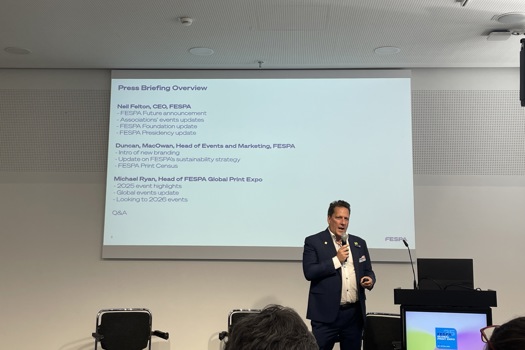But are we as aware or concerned by the content of the goods we buy? Without turning to the front of this magazine, who can say whether it has been printed on virgin, part recycled or 100% recycled paper? A small proportion, I would wager, so what are the odds that the average person in the street notices whether the print or packaging they consume is from a sustainable source, let alone recycled?
For a nation that is so good at recycling its waste, it seems, anecdotally at least, that we are less effective when it comes to using recycled products. In print, while it has been hard to get specific data since the demise of the NAPM, the general impression is that sales of recycled sheets have declined by up to 75% in the past decade.
It is important to note that this excludes newsprint, which reached a recovered paper utilisation rate of 87.5% in 2009 and which still benefits from two recycled mills in the UK, in King’s Lynn (Palm Paper) and Deeside (UPM Shotton), despite the closure of Aylesford Newsprint. “Newsprint has gathered pace to the stage where recycled fibre is really dominating in that market,” says Denmaur Paper marketing director Peter Somerville.
Equally, there are some applications, whether for environmentally conscious brands or simply where recycled has a price advantage, where the overall trend is reversed. “I would say by and large we’re probably producing more work on 100% recycled papers but I think they’re being priced more competitively so that may have something to do with it,” says Prinovis UK commercial director Mark Pfeiffer. “I wouldn’t say there are many people out there really looking at things from an environmental perspective and doing it that way round, I think it’s more that the cheaper paper tends to be recycled at the moment.”
The same could be said of newsprint, in that economics doesn’t really factor into the equation of whether or not to use recycled. “The price of newsprint is the price of newsprint – whether you have virgin or recycled it’s very much a commodity product and I think it’s cheaper to make recycled newsprint closer to the market you’re serving, using an urban forest rather than an actual forest,” says Somerville.
For the bulk of the sheetfed market though, recycled paper has dropped down the agenda and if an undiscerning consumer base is unaware of or indifferent towards recycled paper use, then any decline must surely rest in the hands of the buyers, leading us to ask: have UK paper buyers fallen out of love with recycled?
It’s the economy, stupid
Recycling rates in the UK rocketed in the 10 years following Tony Blair’s arrival in Downing Street in 1997, with government-led programmes such as Wrap having a considerable impact on behaviour. However, as the recession bit a decade later, recycling fell down the agenda.
“Wrap was set up to promote recycling in general,” says Somerville. “In respect of paper, advocates were employed to go around government organisations and then subsequently further afield to businesses to promote the use of recycled papers, this ran out of steam long before the Labour government fell. Basic economics kicked in as virgin products become cheaper, so even the government U-turned on its insistence of using recycled papers.”
German papermaker Steinbeis uses 100% recovered paper in its manufacturing process, dubbed “back to use”. Julie Downey, UK, Australia & New Zealand country manager, agrees that the economy has had the biggest impact on recycled paper use. “I think austerity obviously has a lot to do with it. Past governments have been responsible for driving through initiatives on recycled and the private sector tends to follow the government,” she says.
Ironically, the coalition government was actually “leading the way” on recycling, according to Downey, but its behaviour was not reflective of the wider public sector, where budget cuts drove a lot of buyers away from recycled. “UK central government has a mandate for recycled paper and they go one step further and actually send their waste back to our mill where we turn it back into their paper,” says Downey. “But that only represents a very small percentage of overall government consumption. The larger part is in devolved or local government and certainly within those areas we’ve seen that recycled use has dropped off the agenda, as it has with corporate buyers, throughout the economic downturn.”
Downey estimates that central government paper consumption amounts to between 12,000 and 15,000 tonnes per annum versus 100,000 to 120,000 across local government. “We’ve actually grown our volume in recycled paper, but when you talk to the paper merchants they will invariably tell you that their recycled figures have dropped through the floor,”
she adds.
Partly responsible for this is the fact that we as consumers like our paper bright white as opposed to the slightly blue tint you see with recycled grades. This in turn brings in the cost argument, because high-whiteness recycled sheets are invariably going to be more expensive than virgin grades (up to £200 a tonne more). “Unfortunately the UK is a market that likes a very white sheet so when you’re getting into recycled papers that are very white you’re talking about a paper that is much more expensive than a traditional virgin paper,” says Downey. “By and large people don’t want to move down the
shade category because it’s perceived as inferior, even though from a technical point of view it’s exactly the same. In view of what’s been happening with the economy and austerity, without question it’s really dropped off the agenda.”
Somerville agrees: “I think 2007/08 has had an impact; the recession meant budgets were cut and that has reduced use of high-end recycled paper. People have had to look at budgets and ask what they can do to reduce their spend, right at the point where virgin products became more competitive, so the market started turning.”
However, Leipa UK managing director David Heine argues that, while there is little doubt that the UK market has higher production values than the rest of Europe, this only applies to a small percentage of the market. “In recent years cost pressures have led to an overall reduction in standards across mainstream consumer and retail publishing sectors, including a move away from double coated mechanical grades to single coated, SC and improved newsprint,” he says.
“So if anything the market should have opened up, but there is still a perception about recycled among designers and publishers. We had four titles move over to our grades from a reputable LWC and the publishers did not even notice. We are trying to market ourselves as an LWC first and foremost that happens to be 100% recycled from post-consumer waste.”
If the price is right
The fact that manufacturers of 100% recycled paper are not focusing on the environmental aspect in their own marketing is indicative of the lack of demand for recycled from print buyers. “In publishing I think it’s just about the right product for the right use. It’s got to fit the right weight, opacity, thickness – all those kinds of things that suit the requirement of the magazine,” says Somerville.
Pfeiffer agrees: “The last five years have been fairly quiet around environmental concerns and instead it’s been: what is the most cost-effective way of producing this job? That’s still the absolute overriding benefit. There are clients who are different but the big supermarkets will have the requirement around FSC/PEFC but no real moves towards recycled papers.”
Sustainable sourcing accreditations like FSC and PEFC may actually be harming the recycled market because they have been marketed so successfully. “Because FSC has such a high profile within the UK, a lot of people view it as being as good if not better than recycled paper,” says Downey. “It’s a great logo but it’s not holistic it’s really just concerning the fibre source not being illegal, it’s not getting down to the resource issue.”
Ultimately, the decline in recycled use in the UK does seem to stem from pricing first and foremost. WWF Global Forest and Trade Network (GFTN) manager Julia Young says: “Everything I hear about whether people are buying recycled papers or not comes down to pricing. If people are under pressure on price then they’ll be looking for the best virgin paper they can get in terms of sustainability instead of recycled.”
Buyers that are looking to switch may well turn to the WWF’s own checkyour paper.panda.org website, which rates papers on factors including fibre source, carbon emissions and water pollution. However, Heine argues that sites such as this and the PPA’s carbon calculator may actually be detrimental to recycled paper use, offering a ‘get-out clause’ for buyers looking to switch from recycled to virgin grades. “Paper recycling rates have increased to around 75%, which is very positive but we do need to create a market for recycled (or should we say pre-loved) products, otherwise you need to question the logic,” he says.
Young agrees that buyers might well try to make savings by switching to a well-produced, certified virgin paper if they are under financial pressure and the virgin grade is cheaper than the recycled alternative; however, she is adamant that the WWF’s policy is that “recycled is basically number one because it takes up fibre that’s already in the system and because there’re some really good recycled papers”.
“We really would like to be seeing a different scenario and we really do need to be getting recycled picked up,” she adds. “There are lots of great recycled papers and I do think people sometimes use quality or brightness as a bit of an excuse when actually it’s all down to price.”










